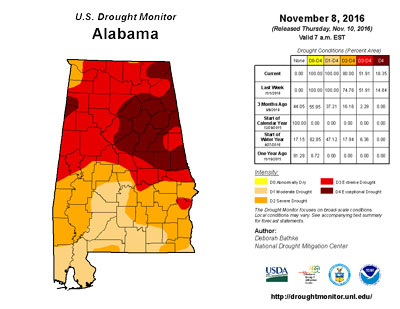Drought Hits Alabama Hard: State Suffers Severe Drought

Drought that began in northeast Alabama this summer has lingered through fall and spread across the state, causing concern for farmers harvesting crops and those trying to find forage for livestock.
Covering Alabama and parts of Tennessee, Mississippi and the Carolinas, the drought and unusually high temperatures left lakes, rivers and ponds at historical low levels. As of early November, the U.S. Department of Agriculture (USDA) declared 41 Alabama counties primary drought disaster areas. Eleven contiguous counties also are designated disaster areas.
“We normally wean our calves in late June or early July and hold them to let them gain weight,” said Marshall County farmer Mike Carnes, who raises beef cattle and poultry. “When we saw the drought getting worse, we sold calves early at lighter weights, and prices were down, too.”
In a year when hay production was already low, Carnes said he was forced to start feeding hay early and sold some of his mature cows. To compound a bad situation, he’s been unable to plant cool-season grazing that normally supplements his winter feed supply.
Lack of precipitation dried ponds, forcing farmers to find alternative water sources for cattle. Cotton, peanuts and other row crops had lower yields in drought areas, especially on non-irrigated land. The dry weather also dipped into Alabama’s nursery industry profits, which saw a drop in fall sales because of water-use restrictions in many metropolitan areas.
Drought, low humidity and tinderbox-like forests triggered 1,421 wildfires from Oct. 1-Nov. 7, scorching 15,409 acres in Alabama. That led Alabama Forestry Commission officials to issue a statewide no-burn order. Last year for the same period, 232 wildfires burned 1,846 acres in Alabama.
The USDA drought declaration brought some disaster assistance for farmers. In addition to low-interest rate emergency loans, farmers may qualify for other FSA programs including the Emergency Conservation Program; Livestock Forage Disaster Program; Livestock Indemnity Program; Emergency Assistance for Livestock, Honeybees and Farm-Raised Fish Program; and the Tree Assistance Program.
Additionally, several state organizations created informational websites to help farmers cope with drought.
The Alabama Department of Agriculture and Industries launched a hay listing web page at agi.alabama.gov/s/haylistings. Farmers with hay to sell may add an entry to the Alabama Hay Listing page, and farmers needing hay can search for listings near their areas.
The Alabama Cooperative Extension System created a website at AlabamaDrought.com with resources for dealing with drought, in addition to holding Livestock Drought Meetings last month.
The Alabama Cattlemen’s Association drought page is BamaBeef.org/Drought. That page includes meeting dates for farmers and alternative feed options.
Alabama Power Co. also launched a website with energy-saving options for farmers, including irrigation information, at tinyurl.com/AlabamaPower.
